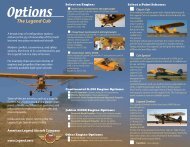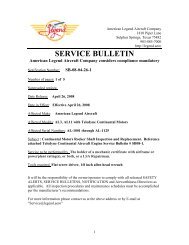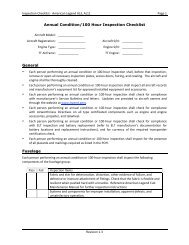Lycoming Flyer - Aircrafts sales, engines repair, spare parts
Lycoming Flyer - Aircrafts sales, engines repair, spare parts
Lycoming Flyer - Aircrafts sales, engines repair, spare parts
- No tags were found...
You also want an ePaper? Increase the reach of your titles
YUMPU automatically turns print PDFs into web optimized ePapers that Google loves.
GOOD VS. IRREGULAR MAINTENANCERegular maintenance, performed by qualified personnel usingfactory-recommended inspection procedures and intervals, willcontribute to engine performance and the capability of reaching themanufacturer recommended TBO hours. Stretching inspection oroil change intervals may create the illusion of saving money, but isreally false economy. Regular oil changes and scheduled maintenanceplay an important role in achieving recommended TBO.FREQUENCY OF FLIGHTFrequency of flight also plays an important part in the operatinghistory of an engine. Engines flown only occasionally and withextended periods between oil changes are subject to corrosionbecause of acids that build up in the oil and attack internalmetallic <strong>parts</strong> of the engine. Only regular oil changes can eliminatethese acids.Moisture that enters through the breather or exhaust system cancause rusting of cylinders and other steel <strong>parts</strong>. Rings may takea set and stick in the groove. Condensation in the magnetos maycause shorting of the breaker points. Flying as often as possible tobring the engine temperatures up to their normal operating levelswill help to eliminate moisture. A ground run of the engine onlyis not considered satisfactory. Frequent flights are needed.The number of hours that need to be flown each month, andthe length of time between flights cannot be specified for everyaircraft and engine. Variables such as geographic location andlocal temperature and humidity must be considered. Inactivityand time will cause hardening of gaskets, seals and hoses. Longperiods between flights can be expected to cause excessive wearduring engine start due to loss of the protective oil film on bearingsurfaces during the long periods of inactivity. Regardless of theoperating hours, those <strong>engines</strong> that have not reached the recommendednumber of operating hours for TBO in a 12-year periodmust be overhauled or replaced during that twelfth year.DECISION TIMEThe timing of engine overhaul or replacement is sometimes theresult of government regulations. Anytime regulations are nota factor, the engine owner must make the decision to overhaulor replace the engine based on knowledge of the engine and theconditions under which it has been operated. This decision maycome before the engine has reached the recommended number ofoperating hours, or in some cases, after that number of operatinghours has been achieved.TBO recommendations apply to the engine, and in some cases,engine accessories and propellers. There is the possibility thatcertain components such as magnetos, ignition harness, governorsand other engine-driven accessories may require overhaulor replacement prior to engine overhaul. This decision, too, is tobe made by the party responsible for maintaining the engine, orby the accessory manufacturer.NEW ENGINEA new engine is a product manufactured by <strong>Lycoming</strong>containing all new <strong>parts</strong> and accessories, and meeting allproduction test specifications, quality control tests and regulationsnecessary to hold and maintain a “production certificate”issued by the FAA. When this engine has met each ofthese criteria and is shipped to an airframe manufacturer, itwill be subject to further testing during flight test of the aircraftfor its certification acceptance. When the ultimate purchaserreceives the aircraft, it may have also been subjected to ferrytime. However, all flight testing and ferry time will be logged.The user then receives the engine with the full <strong>Lycoming</strong> newengine warranty, accompanied by an Engine Logbook.Rebuilt ENGINETo the aircraft engine purchaser, the “rebuilt” engine, as providedby <strong>Lycoming</strong>, offers the opportunity to obtain many of the benefitsof a new engine, but at a price savings.A <strong>Lycoming</strong> factory-rebuilt engine is defined as an aircraft engineoriginally designed and manufactured by <strong>Lycoming</strong> that has beendisassembled, cleaned, inspected, <strong>repair</strong>ed as necessary, reassembled,and tested to the same tolerances and limits as a newitem, using either new <strong>parts</strong> or used <strong>parts</strong> that either conform tonew part tolerances and limits or to approved oversized or undersizeddimensions. Tolerances and limits established and publishedby <strong>Lycoming</strong>, and approved rework procedures, are used duringthe rebuilding of the engine so that the engine is brought back tozero time. It is important to note that the <strong>Lycoming</strong> factory is theonly agency authorized by the FAA to return a <strong>Lycoming</strong> engineto ZERO time. Such <strong>engines</strong> retain their original serial number,but the letter “R” is added preceding the letter “L” on the dataplate which designates rebuilt by <strong>Lycoming</strong>.Thus, a factory-rebuilt engine that has been returned to zero time,by <strong>Lycoming</strong>’s definition, has all the foregoing, plus the fact thatit is done by <strong>Lycoming</strong> at its factory, by factory personnel withmanufacturing and engineering expertise. This factory-rebuiltengine must also meet the same production test specificationsused for a new engine. With each <strong>Lycoming</strong> factory-rebuiltengine, an Engine Logbook is furnished with <strong>Lycoming</strong> FormNo. 489 included on the inside of the first page. Additionally, eachengine released through the rebuilding system is accompanied bya maintenance release that refers to the factory order to which allwork was performed.OVERHAULED ENGINEOverhaul is a term which certainly means different thingsto different people. When the aircraft owner has run afactory-new engine to TBO, and then paid for an overhaul,that owner usually has expectations of running the engineuntil the manufacturer’s recommended TBO has again beenachieved. These expectations may or may not be realisticdepending on what the overhauler puts into the overhaul. Thereis no specific definition of the term overhaul in the Code ofFederal Regulations for Aeronautics and Space (FAR). FARPart 43 states the following about Maintenance, Rebuildingand Alteration.a. Each person maintaining or altering, or performingpreventive maintenance, shall use methods, techniquesand practices acceptable to the Administrator. The tools,equipment and test apparatus necessary to assure com-1 2 L y c o m i n g F l y e r









